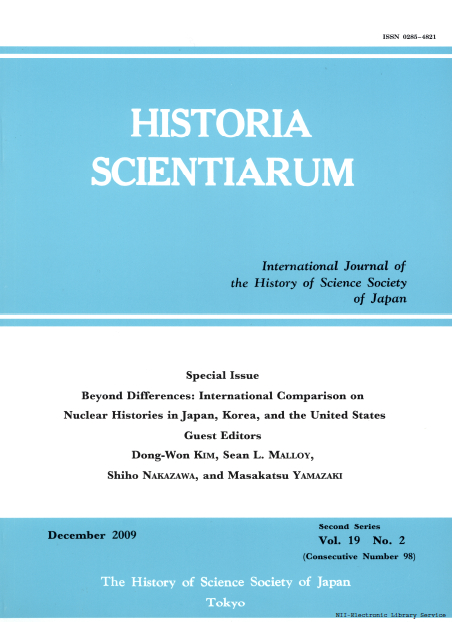Kim, Dong-Won. “Imaginary Savior: The Image of the Nuclear Bomb in Korea, 1945‑1960.” Historia scientiarum: international journal of the History of Science Society of Japan 19, no. 2 (2008): 105‑118.
 This paper traces the image of nuclear bomb in Korea by critically examining various discourses on atomic weapons in the Korean media after the bombing of Hiroshima in 1945. Kim identifies three possible reasons as to how South Korea maintained a strong positive image of nuclear power for over five decades. The bombing of Hiroshima and Nagasaki, which took place in August 1945, forced the Japanese to surrender to the USA. This brought liberation to Korea, which had been under Japanese occupation. The apocalyptic image of the atom bomb in Japan was therefore in direct contrast to the savior image it took on in Korea. While the mushroom clouds spelled disaster for the Japanese empire, it liberated Korea from the brutalities of Japanese occupation. The lack of scientists in Korea combined with a media that reported news fed to them by Western news agencies propagated a positive image of the atom bomb.
This paper traces the image of nuclear bomb in Korea by critically examining various discourses on atomic weapons in the Korean media after the bombing of Hiroshima in 1945. Kim identifies three possible reasons as to how South Korea maintained a strong positive image of nuclear power for over five decades. The bombing of Hiroshima and Nagasaki, which took place in August 1945, forced the Japanese to surrender to the USA. This brought liberation to Korea, which had been under Japanese occupation. The apocalyptic image of the atom bomb in Japan was therefore in direct contrast to the savior image it took on in Korea. While the mushroom clouds spelled disaster for the Japanese empire, it liberated Korea from the brutalities of Japanese occupation. The lack of scientists in Korea combined with a media that reported news fed to them by Western news agencies propagated a positive image of the atom bomb.
During the Korean War, in 1950, the United States threatened to use nuclear power against North Korean and Chinese military and the South Korean newspapers widely popularized the use of atomic bombs against communism. North Korea immediately founded a nuclear physics lab. In 1953, the declaration of the “Atom for Peace” was signed in the United Nations General Assembly and South Korea laid the foundation stone of its nuclear research programs. After signing an agreement for the non-military use of nuclear power, South Korea set up the Atomic Energy Research Institute in 1959. For the citizens of South Korea, however, nuclear power was synonymous with nuclear weapons and the purpose of nuclear research was the development of the nuclear bomb. North Korea’s superiority in nuclear power was a constant threat to South Korea and developing the nuclear research sector was the only way to deter future North Korean invasions.
Finally, the scientific community in South Korea was vastly pro-nuclear power and they played a major role in reinforcing the savior image of nuclear bomb across the nation. Lack of a research community in South Korea before the war meant that the post-war government invested in securing manpower and infrastructure in order to build a strong nuclear nation. As a result, the scientific community owed their existence to the government and they also propagated the savior image of nuclear power.
This paper offers valuable insights into the relationship between science and technology and political power. The concept of using nuclear power for development was predominant in South Korea and this has been imported to its scientific, technological, and political practices. This article can be read along with Sheila Jasanoff’s work on ‘sociotechnical imaginaries’ which shows how national hopes and fears about science and technology can impact public policy.
References:
Jasanoff, Sheila, and Sang-Hyun Kim. 2009. “Containing the Atom: Sociotechnical Imaginaries and Nuclear Power in the United States and South Korea.” Minerva 47: 119-146. [Teach 3.11 annotation]
Gayathri Haridas, Department of Public Policy and Global Affairs, Nanyang Technological University
![[Teach311 + COVID-19] Collective](https://blogs.ntu.edu.sg/teach311/files/2020/04/Banner.jpg)